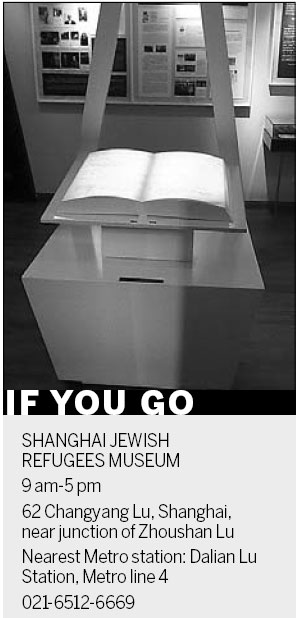Tribute to the jews
Updated: 2012-03-18 08:01
By Zhang Kun in Shanghai(China Daily)
|
|||||||||
North Bank Suzhou Creek tells the story of thousands of Jewish refugees finding shelter in Shanghai during World War II, and this original musical production will premiere at the Shanghai Jewish Refugees Museum on March 22.
From 1933 to 1941, the city received more than 40,000 Jewish refugees, mainly because it was an open port that did not require a visa for entry. These Jews made Shanghai their home, established businesses, got educated and fell in love here.
"The play is fictional, but there are many true stories behind it," says Han Yi, from the museum.

An exhibition in Haifa, Israel is also telling the stories of Jewish life in Shanghai till the end of March, and the Shanghai museum plans to put on an exhibition in April in collaboration with a history museum from Auschwitz. It will be at a venue that is a simulation of a real Jewish shop in Hongkew Ghetto.
North Bank Suzhou Creek draws heavily from the memoirs of Fred Antman, A Tale of Three Cities. Antman, now 82 years old and grandfather of six, has been president of the Elwood Talmud Torah Hebrew Congregation for 24 years. He decided to record his life story from Berlin to Shanghai and then to Melbourne, Australia.
In August 2011, Antman and his wife, Eva, came back to Shanghai for the first time after they left in 1946, and he presented his memoir to the museum.
The museum itself is on the site of an old synagogue on Ward Road, where the Jewish population worshipped after they were forced to move into the Hongkew Ghetto during the War of Resistance Against Japanese Aggregation (1937-45).
Antman arrived in Shanghai with his parents and brother from Berlin in 1939, refugees from the massacre in Germany. He was just a boy of 9. Here, he went to school, served as the captain of the school football team, and met the love of his life, Eva.
The Antmans were originally from Poland, and Fred's father, Samuel, and his brother were sent to Berlin by their parents to protect them from conscription to fight in World War I. When Fred was born in 1930, Samuel was running a tailor's shop in Berlin, making garments for women.
The family's peaceful life was shattered when Samuel was taken away by the Gestapo. As a boy of 8, Fred witnessed the "Kristallnacht" from the third-floor apartment window, when stained-glass windows were smashed and Torah scrolls thrown into the streets.
It was his mother Erna who saved them, Antman recalled.
"My mother clearly realized that amid all this Nazi violence and madness there was no future for Jews in German," Antman wrote in the memoir. "She rushed to a travel agent, and learned that there were only two places that did not require entry visas: one was La Paz in Bolivia and the other was Shanghai, China."
Erna Antman booked the last four tickets for Shanghai. The Antman family soon settled in the new home city, and Samuel served as the cantor for the synagogue.
In 1941, after the Japan attacked Pearl Harbor, the Ghetto was established in Hongkew area, where no Jew could leave without permission. It was in Hongkew that Fred met Eva Teicher, who had fled Berlin to Shanghai two months before the Antmans.
Eva was two years younger than Fred, and a naturally happy girl, but the horror of war still haunts her. And in 1946, Fred and Eva had to part after World War II, as the two families decided to leave Shanghai, the Antmans to Australia, and the Teichers to the United States.
"Three times in his life, my father had to start his business from scratch," Fred Antman says, "In Berlin, then Shanghai, and again, Melbourne, after the war."
Samuel worked hard, with the help of Fred, to build Antman of Melbourne into an award-winning garment brand available in major department stores in the country. To Fred's great joy, Eva and her family moved to Australia, and they got married in 1953.
zhangkun@chinadaily.com.cn
(China Daily 03/18/2012 page15)